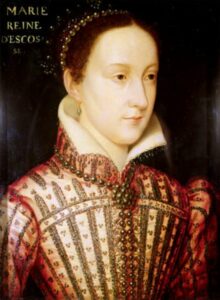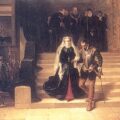
On this day in history, at six o’clock on the morning of Tuesday 19th August 1561, Mary Queen of Scots landed at Leith harbour, in Scotland, the country of her birth. The reason for her return to her homeland was the death of her husband, Francis II King of France. He died in December 1560 and was succeeded by his brother, Charles IX, with his mother, Catherine ‘de Medici acting as regent for the 10 year old boy. As John Guy points out in “My Heart is My Own: The Life of Mary Queen of Scots”, “Mary had no place in Catherine’s plans” and Catherine was intent on revenge on the Guises and on frustrating any plans they might have. Mary knew that there was no sense in her staying in France, so she handed her jewels in to Catherine and set about planning her return to Scotland and making a fresh start there.
While she was planning her return, she received a visit from Sir Nicholas Throckmorton and the Earl of Bedford who had been sent by Elizabeth I to get Mary to ratify the Treaty of Edinburgh. Mary refused, pointing out that she was “without counsel”. John Guy explains how William Cecil, Elizabeth I’s primary adviser, saw Mary’s refusal as a hostile act and a refusal to accept Elizabeth as England’s rightful ruler. In his eyes “she was the prime mover of an international Catholic conspiracy to depose and kill his Queen” p125 Mary was just 18 but she was already causing problems for Elizabeth I and her government.
Scotland too was wary of Mary’s planned return. There had been a revolt in 1559-60 against the regency of Mary’s mother, Mary of Guise, which resulted in her deposition. Mary was briefed on this by Henri Cleutin, Seigneur d’Oysel, her mother’s former chief lieutenant, and he advised her to give her support to Lord James Stuart, her illegitimate half brother, even though he had had a prominent role in deposing her mother. D’Oysel knew that he was the only one who could hold the Scottish Lords together and John Guy writes that “the trick for Mary would be to turn her illegitimate brother from a virtually autonomous agent into a royal servant. If she could do that, she could succeed in ruling her country as well as any of her royal predecessors.”
Mary Queen of Scots left the port of Calais on the 14th August and as her galley left the harbour a ship collided with another vessel and sank, drowning all of its crew. Mary worried that this was a bad omen. John Guy writes that the usually courageous and composed Mary broke down and burst into tears as the French coast disappeared from view:-
“Her last words as her galley sailed into the open sea were ‘Adieu France. It’s all over now. Adieu France. I think I’ll never see your shores again.’ “
Source
- My Heart is My Own: The Life of Mary Queen of Scots, p118-133, John Guy







